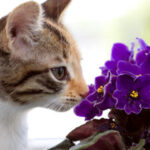Constipation is a frequent health concern for domestic cats, characterized by infrequent bowel movements or difficulty passing dry, hard stools. Addressing constipation promptly is crucial to prevent it from worsening and leading to more severe complications.
Several factors can contribute to Constipation In Cats. These range from simple issues like ingesting indigestible materials, such as fur, to more serious underlying health problems. Understanding these causes is the first step in effectively managing and preventing constipation in your feline companion.
Understanding the Causes of Constipation in Cats
Pinpointing the exact cause of constipation in cats can sometimes be challenging. However, common culprits include:
- Ingestion of Indigestible Material: Cats are meticulous groomers, and as a result, they often swallow hair. Accumulated fur in the digestive tract can lead to hairballs and contribute to constipation.
- Gastrointestinal Obstructions: Blockages in the GI tract can be caused by foreign bodies that cats ingest (like string, toys, or bones), tumors, or strictures (abnormal narrowings of the intestinal passage).
- Dehydration: Insufficient water intake can lead to harder stools, making them difficult to pass. Dehydration is a significant factor in many cases of feline constipation.
- Electrolyte Imbalances: Disruptions in electrolyte levels in the body can affect muscle function, including the muscles of the colon, leading to constipation.
- Neuromuscular Diseases: Conditions affecting nerves and muscles can impair the normal contractions of the intestines needed for bowel movements.
- Medications: Certain drugs can have constipation as a side effect in cats.
- Idiopathic Constipation: In many instances, the specific cause of constipation remains unidentified. This is termed idiopathic constipation, meaning the condition arises spontaneously or from an obscure or unknown cause.
Alt text: A ginger cat is using a clean litter box, illustrating healthy feline bowel habits and the importance of monitoring litter box activity for signs of constipation.
How to Treat Constipation in Cats
Treatment strategies for constipation in cats vary depending on the severity and underlying cause. It’s essential to consult with a veterinarian for proper diagnosis and a tailored treatment plan. Common approaches include:
- Hydration: Ensuring your cat is well-hydrated is paramount. Fresh water should always be available. In some cases, veterinarians may recommend subcutaneous or intravenous fluids to rehydrate the cat effectively.
- Addressing Underlying Causes: If a specific cause, such as a foreign body obstruction or medication side effect, is identified, treatment will focus on resolving that underlying issue.
- Medical Management:
- Laxatives: These medications help soften stools, making them easier to pass. There are different types of laxatives, including stool softeners and lubricants. It’s crucial to use laxatives specifically recommended by a veterinarian and avoid human laxatives, which can be harmful to cats.
- Enemas: Enemas involve introducing liquid into the colon via the anus to hydrate the stool and stimulate bowel movements. While some cat owners can administer enemas at home after veterinary instruction, it’s often a procedure best performed by a veterinarian, especially if the cat is stressed or uncomfortable. Sedation may be necessary for some cats during enema administration.
- Intestinal Motility Modifiers: These medications increase the contractions of the intestinal muscles, helping to move feces through the digestive tract more efficiently.
Alt text: A veterinarian gently administering oral medication to a cat, representing the medical treatment options available for feline constipation, such as laxatives and motility modifiers.
Dietary Changes to Combat Constipation
Dietary modification plays a significant role in managing and preventing constipation in cats. Increasing fiber intake is often recommended. Fiber can be broadly classified into two types:
- Insoluble Fiber: Sources like cellulose add bulk to the stool, which stimulates the colon to contract and move waste along. However, insoluble fiber can also decrease fecal water content and potentially reduce nutrient digestibility if overused.
- Soluble Fiber: Examples include canned pumpkin and psyllium. Soluble fiber ferments in the colon, producing short-chain fatty acids that can encourage colonic muscle contractions and improve stool consistency. However, excessive soluble fiber can lead to diarrhea and hinder nutrient absorption.
Fiber supplementation can be achieved by adding fiber-rich foods to your cat’s current diet or switching to a commercially prepared high-fiber cat food. It’s essential to introduce dietary changes gradually and monitor your cat’s stool consistency to find the right balance.
Alt text: A healthy cat enthusiastically eating from a food bowl, highlighting the role of a balanced and potentially high-fiber diet in maintaining regular bowel movements and preventing constipation.
Megacolon and Severe Constipation
In severe, untreated cases, chronic constipation can progress to megacolon. This is a serious condition where the colon becomes significantly enlarged and loses its ability to function properly. Obstipation, a form of severe constipation where the cat cannot evacuate the colon at all, can also occur.
Megacolon and obstipation are often unresponsive to medical management alone. In these critical situations, surgical removal of the affected part of the colon (colectomy) may be necessary. Surgery aims to prevent bacterial translocation from the GI tract into the bloodstream, a life-threatening complication.
When to Seek Veterinary Care
Constipation in cats should not be ignored. If you observe any of the following signs, it’s crucial to consult your veterinarian:
- Infrequent bowel movements (less than once every 24-48 hours).
- Straining or vocalizing in the litter box.
- Small, hard, dry stools.
- Pain or discomfort during defecation.
- Loss of appetite or lethargy.
- Vomiting.
Early intervention can prevent constipation from becoming a chronic and more serious issue, ensuring your cat’s digestive health and overall well-being.
Last updated 2023

